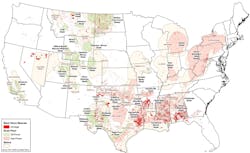An alternative to the traditional E&P
BLACK STONE MINERALS SEES ITS BUSINESS MODEL AS LESS RISKY OVER TIME WITH A HIGHER ROI
PHOTOS BY SYLVESTER GARZA
EDITOR'S NOTE: With roots dating back to the late 1800s, Black Stone Minerals LP is one of the largest oil and gas mineral and royalty companies in the United States. The Houston-based firm has interests in over 18 million gross acres in 40 states and throughout every major producing basin. Thomas L. (Tom) Carter Jr., president, CEO, and chairman of the General Partner since 2014, recently agreed to an interview with OGFJ.
OIL & GAS FINANCIAL JOURNAL: Black Stone has been around since 1876 and is now the largest publicly traded yield vehicle focused on oil and gas mineral and royalty interests in the US. Tell us a little about the company's history and your business model in the current economic environment.
TOM CARTER: Black Stone, per se, really got its start in 1980, yet it had a close relationship with the W.T. Carter & Bro. family partnerships and the mineral estate that family retained when, like many other East Texas lumber companies, it "sold out" in 1968 to larger forest products entities seeking expansion and timber feedstocks.
Black Stone management owned interests in those minerals and the company was new and very much in the business of prospect generation and marketing. After some trial and error, Black Stone and W.T. Carter, along with several other special purpose partnerships, formed a very close working relationship to exploit not only Carter acreage, but other lands too. That all eventually ended up in a partnership combination that was the real "second generation" of W.T. Carter & Bro. teaming with Black Stone Minerals and the Randall, Stuart, and Sinclair families, among others.
In the beginning of "current times," the early 1990s, we were outliers in trying to buy larger, relatively contiguous minerals in East Texas and around the country, many of which had an absolute dearth of production on them, but we thought these were prime targets for promoting new drilling activity.
And for a good 10 to 15 years, we were the most active mineral aggregator in the market and were able to add significant scale through acquisitions. While we always had competition, multiples were much lower than today (but risk-free interest rates were much higher) and putting a great set of minerals together wasn't easy, but it sure had less traffic and capital than now.
OGFJ: Black Stone Minerals LP has a unique strategy for an E&P company. What differentiates Black Stone Minerals from traditional E&P companies, including MLPs?
CARTER: Let me answer that question this way. You describe us as an E&P company… and I suppose we are, with some very fundamental differences from traditional E&Ps, be it an MLP or a C-corp.
The main difference is the "E" in E&P. While "E" stands for Exploration and "P" for Production, "E" also stands for capital and lease operating Expenditures. Many E&P C-corps and most of the E&P MLPs ran into trouble because of the enormous capital required to acquire and develop oil and gas leases. Historically, of course, much of those costs were financed with "low-cost" debt.
When we buy a mineral property for a multiple of cash flow, in many respects our "E" dollars are spent on buying yet underdeveloped lands that have to work out later for our own returns to materialize. That in some cases is a different risk profile from a very large upfront land grab cost, followed by exploration wells and seismic costs. And there is the perpetuity factor of owning minerals versus leasehold. You get multiple kicks at the can if the first pass fails.
Other than for acquisitions or in connection with our limited working interest program, we have no capital or lease operating costs. That bears repeating: we have zero non-discretionary capital requirements. Our business is attracting other companies' capital on to our mineral acreage. In part because of this and in part because of our conservative philosophy around leverage, we maintain relatively low debt balances compared to traditional E&P companies.
At the end of the day we see our business as less risky over time with lower unrisked IRRs and probably higher ROIs. We have somewhat less control over the drill-bit, yet the trade-off is meaningfully more diversity of opportunity and inventory per capex dollar spent. And last but not least, we pay an attractive, stable, and growing distribution.
OGFJ: From the perspective of a mineral and royalty owner, how do you see the industry changing? What is driving increased interest in the mineral rights business?
CARTER: I really see the mineral and royalty business changing in many ways that are industry wide. First, technology has really been a game changer in the lower 48. Second, we have lands that we have owned for years that have had quite good returns historically and that are being recharged by technology.
At the same time, one phenomenon that has changed for mineral companies due to improvements in technology and the shale revolution is this: so much more land in site specific areas has been meaningfully de-risked, almost like a mining operation. That really affects multiples of current cash flow one has to pay for minerals in many plays. The Delaware Basin is an area that comes to mind.
I would also suggest that institutional capital is finding yield and returns harder and harder to come by in a "lower long-term return" environment and because of that there is probably more capital chasing the set of opportunities and more shops working this side of the street. In that sense, I am very glad we started when we did, put together such a great footprint, and it just keeps on giving. It could not be replicated easily today.
OGFJ: How do increases and decreases in oil and gas prices affect your operations and financials? Are you more or less exposed to commodity prices than traditional E&P MLPs?
CARTER: Commodity prices definitely affect us. The primary ways are twofold: First, our greatest use of cash flow is our distribution, not capex or interest or debt costs, so prices going down or up have an effect on the amount we have available to pay out to our unitholders. We are hedged fairly aggressively over a 12- to 18-month cycle, to limit the impact of price exposure on our distribution. Second, because we are dependent on third-party drilling capex on our lands, more capital in the industry is better, and prices have everything to do with that.
So we have both direct and indirect commodity exposure, but with no capex or operating costs, and low leverage, we certainly do not have the kind of existential exposure, if you will, that many of the traditional E&P MLPs had.
OGFJ: Why don't more publicly traded companies pursue the mineral and royalty interest ownership strategy?
CARTER: There are larger E&P and international companies with large legacy mineral positions built over generati ons - those include Exxon, Chevron, BP, Devon, Noble… the list goes on. They really like owning minerals, and it's very hard to get them even to entertain selling. Those companies are very large with big capital budgets and so it's hard for minerals to be core, but sometimes they are.
We've seen some examples of smaller C-corps buying minerals in front of their drill bit. I think that is an interesting strategy, but there is a limit to how broadly it can be applied. E&Ps are in the business of drilling wells, so diverting capital to buy minerals when you probably have existing leasehold that needs to be drilled is something that will give a lot of management teams pause.
For the smaller aggregators, access to capital and the challenge of actually acquiring minerals at attractive returns can be daunting. It's not for the faint of heart or three-year capital horizon players.
I'd also suggest that we have some ways to go before gaining the proper level of understanding and appreciation for the minerals business with the public market. Too many still paint us with the same brush used for the E&P MLPs, and as I discussed earlier, we are fundamentally different. I believe minerals assets, especially those with sufficient scale and diversity, are a great fit for the MLP structure. I suspect as we continue to perform and to educate investors, public market reception will improve and additional minerals companies will come into the sector.
OGFJ: In February of this year Blackstone completed a farmout agreement in a portion of its Haynesville and Bossier shale assets. What are the benefits for farming out your working interest instead of participating with a working interest in a well? Is there an ideal working interest to mineral and royalty rights mixture that you manage your business to?
CARTER: From the outset I have emphasized two things above others. First, promote our minerals. Second, attain some level of input, or what I like to call "navigational influence" in the timing of development of a property, much akin but not exactly like an operator.
We don't wait for the phone to ring with a lease request. We do a lot of that, but we work over our inventory to keep it as active as possible. Industry players know we do this and because we are active we get incoming and home-grown negotiations going on large and small opportunities.
We also will keep participation rights not only for the economics, but if we are a working interest partner we can work with the operator to understand and prompt activity in a way not readily doable exclusively as a mineral owner.
Now, the farmout in what we call Brent Miller, operated by XTO in the Shelby Trough of the Haynesville/Bossier, was a very unique, and in retrospect, successful new course for us. XTO and another former major Haynesville player had a large lease from Black Stone. The other operator decided they had had enough when commodity prices fell and the learning curve on drilling and completion in that play was in its infancy.
XTO, on the other hand, wanted to keep the play moving, albeit cautiously, and asked us to step into the other partner's 50% working interest position. This working interest was more than four times our typical working interest participation level and is very expensive territory. But, at the time, we looked at this as an investment in our own long-term potential, as not doing so would have significantly slowed development of that area.
Fast forward, XTO has done a great job with that play both technically and in driving costs down. XTO has drilled and completed about 25 wells since we joined them and there are hundreds more locations. Furthermore, the success there has had a very positive effect on our broader acreage position in the area, and business is booming in that play.
But if you just say, for example, that in a given well, we may have a 15% royalty net revenue interest, and we keep adding 50% W.I. on top of that, well, you just start messing with the chemistry of our production profile. And we felt like the pump had been significantly primed there to bring in low cost capital to drill alongside XTO under a non-op co-investment strategy keeping the capex going, but allowing BSM to curtail working interest as a percentage of total and deploy that capital to other higher ROI mineral opportunities in that play and others.
OGFJ: Black Stone was able to remain fairly active during the last two years despite the price downturn. How have you been able to manage through the latest cycle without cutting your distributions?
CARTER: We are able to maintain and grow our common distribution for three reasons. First, we had a great coverage ratio for common units, which are publicly traded, because the legacy owners subordinated a significant piece of their returns to assure the public of stable to growing returns. Second, our asset base has actually continued to grow on a total production basis through this cycle despite rig counts cratering. And lastly, our balance sheet was and is clean and we were able to keep paying owners versus creditors.
OGFJ: There seems to be renewed interest in the Haynesville from investors and operators alike. As a core operating area for BSM with approximately 300 thousand net royalty acres targeting the play, what new developments in the play are you seeing and is it economic today?
CARTER: The Haynesville/Bossier, after being a bit of a stepchild, has absolutely come into its own with modest natural gas price stability and the improvements in drilling and completion technology. We do absolutely have a tremendous base there and in the last six months have experienced a five-fold increase in acreage owned under defined development agreements. We see that as the single largest growth source over the near future.
That said, in 2007, just 10 years ago, no one outside the geology groups of a few leaders in that play even knew what the Haynesville/Bossier was. That's one of the advantages we see to our very large and diverse portfolio of minerals: we consistently benefit from new break-out development activity somewhere across our asset base. We call these cost-free new growth opportunities "embedded drop downs" and expect to continue to see more of them.
OGFJ: What is driving the renewed interest in the Haynesville?
CARTER: There are many factors to the rebirth of the Haynesville, including stabilizing gas prices, developed infrastructure with international reach via LNG on the Gulf Coast, scale, and cost structure versus other plays of large size.
Many of the next-generation completion techniques honed in other basins like the Bakken, Eagle Ford, and Permian were slow to be deployed in the Haynesville. We are seeing the benefits of those now. For example, XTO has cut frac stage lengths in half, doubled proppant intensity, and added over 2,500 lateral feet on certain well completions in the Shelby Trough. The results have been outstanding; we are seeing some of the best performing gas wells in the country drilled right in our back yard.
OGFJ: Oily plays like the Permian have become the main focus for a number of companies around the industry. How does Black Stone think about balancing its oil to natural gas ratio?
CARTER: Well, we are weighted to natural gas currently on a production basis but more balanced with respect to cash flow contributions. The expected growth in the Haynesville will further increase our natural gas exposure. We are comfortable with that and have no intention of forcing some specific ratio. We believe it would be very difficult, expensive, and risky to try to make a meaningful mid-course correction on commodity type by jumping into the Permian with some mega-deal, for example. With that said, we like the Permian, Bakken, and Eagle Ford strategically and will continue to put capital into those plays. Ultimately, we are focused on returns much more than any targeted oil to natural gas ratio. That makes us relatively agnostic in terms of the specific commodity, but we believe we will deliver the highest long-term value to our unitholders.
OGFJ: With such a diverse portfolio, how do you think about growing operations and capital allocation across your portfolio?
CARTER: We went public in 2015 with about 25 MBOE/day and we see 40 + MBOE/day in the not too distant future, despite just coming through a very, very tough time for our industry. We will grow our business by continuing to be creative with industry operators to seek a disproportionate share of their capital in plays where our resource size and concentrated positions allow.
In addition to the cost-free growth we expect from the embedded drop-downs I discussed earlier, we will continue to be an active consolidator in the minerals space, through both bolt-on transactions and through larger, diversified packages where we see ourselves as the natural counterparty.
OGFJ: Are you focused on mineral acquisitions. and how do these prices compare to traditional lease acquisitions?
CARTER: Yes, we have grown through acquisitions over several decades and plan to continue that course. Typically, mineral acquisitions are up to 5x to 10x more per acre than a traditional lease acquisition, but we believe in the much higher value of minerals given the nature of the perpetual ownership.
OGFJ: What makes an asset a potentially attractive acquisition for BSM?
CARTER: We focus on long-term returns with appropriate capital outlays and risks. It's no secret that we're looking for something that is going to be in harm's way of the drill bit. The type of deals we like most are larger, diversified mineral packages. We like to believe that we have some competitive advantages that allow us to generate incremental value from those types of assets. We're generally more successful in processes for those types of assets compared to more concentrated assets. That is not to say that we don't look at more concentrated asset packages, but those tend to be easier to understand and value and as a result they attract more competition.
OGFJ: Thanks very much for your time, Tom.



